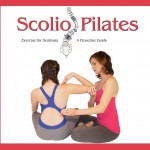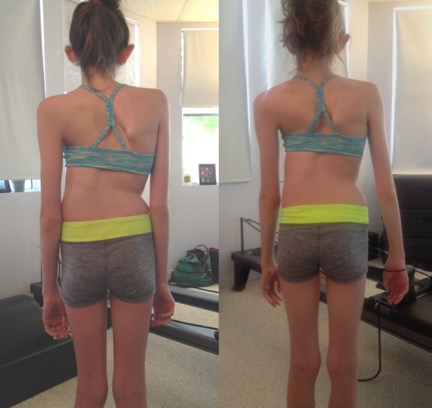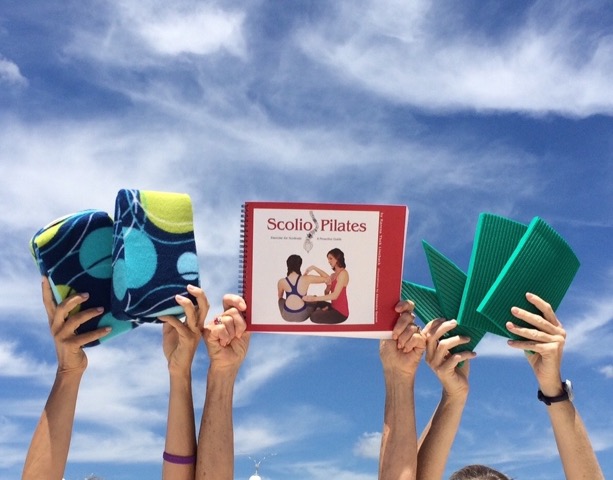Scolio-Pilates – the Review by Rebekah Le Magny
Karena Thek Lineback, a former dancer and a sufferer of scoliosis, discovered Pilates while still a student. She has authored three books, The Pilates Golf Athlete, Osteo-Pilates and Scolio-Pilates, and is currently working on a new project, Neuro-Pilates. Karena travels the globe teaching workshops and working intensively with scoliosis sufferers. I recently attended her Scolio-Pilates workshop and enjoyed her sunny and down to earth personality. She was quick to put the worskhop’s “scoliosis models” at ease. Before the models arrived, Karenna reminded the workshop participants to show sensitivity – for example not to gasp with surprise when viewing their spines. This may seem like common sense, but Pilates teachers, like doctors and therapists, despite noble intentions, are at times guilty of treating students as “cases” and not as human beings.
Scolio-Pilates begins with a definition of scoliosis, its causes, treatment and negative effects. Scoliosis is generally treated in one of three ways – observation, bracing or surgery. Oddly, exercise is not widely acknowledged as a viable treatment despite studies showing its potential effectiveness. Exercise can potentially reduce curves significantly, improve lung capacity, slow the progression of scoliosis and reduce pain and even ease the transition to non-brace wearing.
About twenty percent of scoliosis is caused by disease while the rest is considered idiopathic (no known cause). A spine whose curves exceed ten degrees is generally described as scoliotic. Of utmost importance when treating is to know that the curves are three dimensional, like a spiral staircase whose spirals change direction two or more times as first described by Katherina Schroth in her widely known 1924 study. Schroth’s work uses breath to treat and elongate the spine, as explained in “Three Dimensional Treatment for Scoliosis”. One can see a definite influence on Karena’s treatment protocols for scoliosis, which use breath work, elongation and Pilates exercises to lengthen, strengthen and straighten the spine.
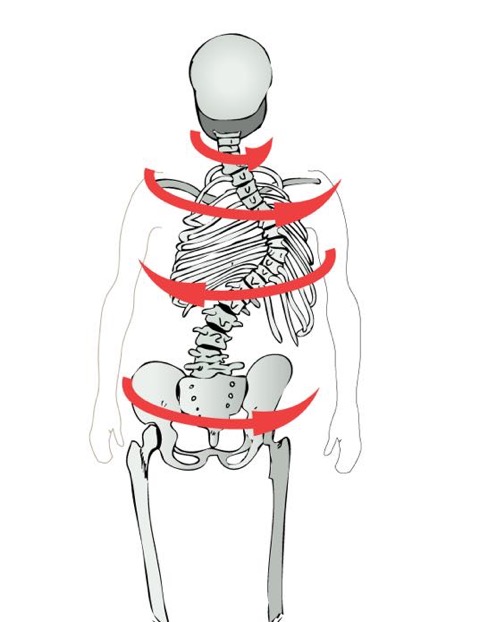
Scolio-Pilates delves into the specifics of a scoliotic spine. Curves are usually referred to as S or C curves. The most common manifestation is what Karena calls the Ashlyn 3-curve (Ashlyn is a model in the book.). In the Ashlyn curve, which is an S, the hip protrudes on the left side and there is a posterior right lumbar convexity (or bump). The student with this “typical” scoliosis generally shifts his weight onto his left leg. Other “clues” to look for are left foot pronation, elevated left waistband, winged right scapula and right ear tilting toward the shoulder. In the “Becky four curve” also an S curve, the lumbar-sacral spine has an extra curve. While the Ashlyn and the Becky curves are the most common; the variations are infinite.
This is Ashlyn, before and after treatment.
Karena explained to workshop participants that identifying the spine’s curvature can be difficult, particularly if the student is athletic and well-muscled (Pilates practitioners, for example)! A scoliometer (downloadloadbale via smartphone) is extremely useful to identify and measure a scoliosis. Teachers can also application onto a smartphone. Karena recommends also reviewing the student’s X-rays.
Karena then illuminates her Scolio-Pilates methodology. Although many Pilates schools teach instructors to place a pad under the spinal concavity so that the student presses into the pad, the Scolio-Pilates method takes the opposite approach. Teachers place wedges under the convexities, (the “bumps”), which lifts the convex sides and allows the concave sides to lower with the help of gravity. Tight muscles can then lengthen and overstretched muscles can shorten. The wedges help the student to realign, but neither student nor teacher is passive. The teacher must cue elongation and de-rotation of the body, which as you remember spirals three-dimensionally.
The primary curve is the catalyst for the other curves, which are the spine’s way of reorganizing itself to compensate for the primary curve. Once the teacher addresses the primary curve by wedging, the resulting compensations become more visible and thus easier to correct.
Because the Ashlyn and Becky curves are the most common manifestations of the scoliotic spine, Karena provides “correction keys”, or “ cheat sheets“ on wedge placement for students with similar curves. If the student’s scoliosis is not an Ashlyn or Becky curve, but the teacher adheres to the methodology, “prop what is dropped”, he should with some experimentation be able to place the wedges correctly. Pilates teachers are skilled in finding optimal alignment, so if they follow their eyes and their instinct for cuing and spotting, they will be successful. Once the pads are in place, the student will then perform a number of breathing or Pilates exercises to strengthen the body in its optimized alignment.
Karena provides several illustrated exercises. Some are breathing and elongation exercises; some are classical exercises (footwork on the reformer, the hundred, and double leg stretch, for example) on the mat and the apparatus; many are contemporary. Once a teacher understands the methodology, he can adapt most Pilates exercises for his use.
I tested what I learned from Karena on my students with scoliosis. Although Pilates had already helped them, this method definitely promises to produce more effective results. I had tools to bring students to a greater understanding of their bodies, and was able to provide “homework”. I also tested the method on my own “shifty” left pelvis, featuring an audible pop in my thoracic spine when I extend my right leg, despite my diligent stabilization efforts. Placing a small pad under the slight left convexity in my lower back and pelvis and correcting the compensations, prevents the popping.
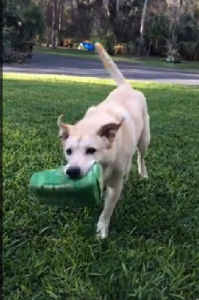
I explained Karena’s technique to a wonderfully talented friend and teacher with decades of experience and she found it helpful with her pelvic shift, and for her students. The wedges involved can be made by anyone handy with a sewing machine, but Karena’s (available here) sport very cool patterns ( and dogs love them!! ). I highly recommend Scolio-Pilates, and Karena’s seminar (additionally, Karena has free videos on You Tube) – a resource that you will refer to time and time again.
Scolio-Pilates – Exercise for Scoliosis, A Proactive Guide by Karena Thek Lineback
Order at www.osteoPilates.com, price 54.95
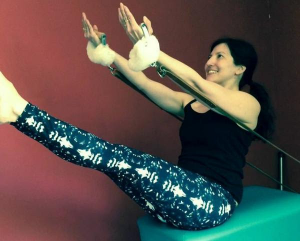 A former corporate finance lawyer (let’s be honest, not a particularly talented one), Rebekah Le Magny woke up one morning (figuratively, because she had pulled yet another all-nighter) and decided that stinky negotiating rooms and making the rich richer was no longer the life she wanted to lead. She got certified to teach pilates by Romana Kryzanowska, had a few dozen children (well, four) and has been teaching for over ten years in Paris. She is also certified to teach vinyasa and hatha yoga and teaches pilates and yoga in her “intimate” (tiny)home studio, Atelier R Pilates Yoga in Saint Maur des Fossés, just outside of Paris. When she is not teaching, she enjoys running, swimming, reading (check out The Pilates Book Review and Discussion Club) and trying to figure out ways to feed her family without cooking. She is still a miserable negotiator who cannot even negotiate adequate computer time with her kids. For more information, check out her Facebook page, Atelier R Pilates Yoga and website, www.pilatesyoga-saintmaur.fr.
A former corporate finance lawyer (let’s be honest, not a particularly talented one), Rebekah Le Magny woke up one morning (figuratively, because she had pulled yet another all-nighter) and decided that stinky negotiating rooms and making the rich richer was no longer the life she wanted to lead. She got certified to teach pilates by Romana Kryzanowska, had a few dozen children (well, four) and has been teaching for over ten years in Paris. She is also certified to teach vinyasa and hatha yoga and teaches pilates and yoga in her “intimate” (tiny)home studio, Atelier R Pilates Yoga in Saint Maur des Fossés, just outside of Paris. When she is not teaching, she enjoys running, swimming, reading (check out The Pilates Book Review and Discussion Club) and trying to figure out ways to feed her family without cooking. She is still a miserable negotiator who cannot even negotiate adequate computer time with her kids. For more information, check out her Facebook page, Atelier R Pilates Yoga and website, www.pilatesyoga-saintmaur.fr.

